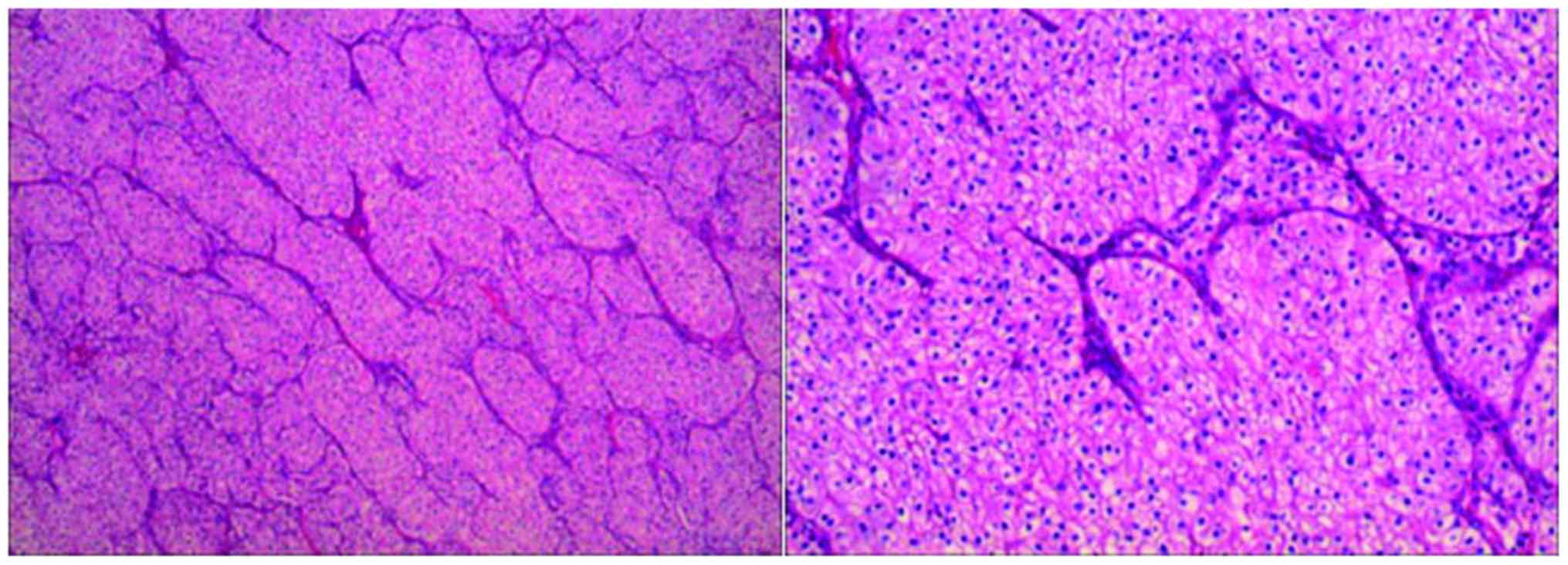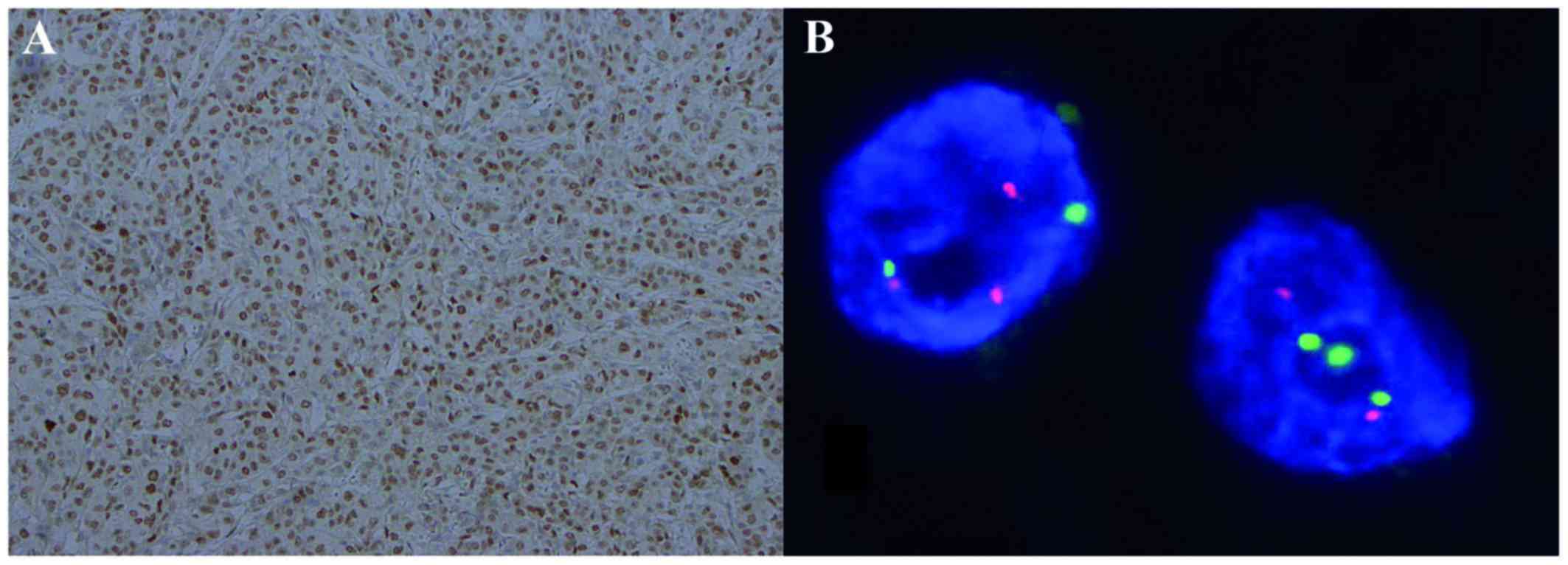Xp11.2 translocation renal cell carcinoma with TFE3 gene fusion: A case report
- Authors:
- Published online on: November 13, 2017 https://doi.org/10.3892/mco.2017.1497
- Pages: 83-85
Abstract
Introduction
The most common type of kidney cancer is renal cell carcinoma (RCC), constituting ~85% of malignant renal tumors and 3–6% of all adult malignancies (1). RCC is a heterogeneous malignancy, the most common histological subtypes being clear-cell (60–75%), papillary (10–15%), chromophobe (5%), and collecting duct carcinoma, each of which are associated with specific histopathological and genetic characteristics. In the 2004 World Health Organization renal tumor classification, the Xp11.2 translocation RCC with TFE3 gene fusion is described as a distinct entity (2). Furthermore, Xp11.2 translocation RCCs have been reported as being more aggressive and having a poorer prognosis compared with other subtypes of RCC (3). In addition, Xp11.2 translocation RCCs are generally considered a pediatric cancer, accounting for 20–40% of pediatric RCCs and only 1–1.6% of adult RCCs (4,5). In addition, adult Xp11.2 translocation RCC has a poorer prognosis compared with its pediatric counterpart (6). This type of RCC is generally characterized by a range of translocations on chromosome Xp11.2 leading to a gene fusion between TFE3 and at least 6 possible partners (7). The diagnosis of Xp11.2 translocation RCC is based on fluorescent in situ hybridization (FISH) rather than histological characteristics and imaging examination (8). The majority of patients with Xp11.2 translocation RCC present at a more advanced stage compared with conventional RCC (9). Surgical resection is considered as the most effective method for the treatment of Xp11.2 translocation RCC.
We herein report a rare case involving an elderly patient with Xp11.2 translocation RCC with TFE3 gene fusion, and review the relevant literature.
Case report
A 70-year-old man was diagnosed with a solid mass in the right kidney during a routine health examination and consulted a doctor at the Department of Urology, Peking University Shenzhen Hospital (Shenzhen, China) on June 9, 2015. The patient was healthy prior to the discovery of the tumor, and he had no surgical history, no family history of cancer, and no history of smoking or drinking. The routine blood tests were normal. A computed tomography scan revealed a solid mass in the right kidney, sized 6.1×5.6×8.2 cm (Fig. 1).
As there were no contraindications to surgery, the patient underwent radical right nephrectomy on June 15, 2015. The surgery was successful, and the size of excised kidney was 8×13.5×6.5 cm. On pathological examination, a proportion of the tumor cells were arranged in nests and had a clear cytoplasm, whereas the remaining cells were arranged in a papillary pattern and had eosinophilic cytoplasm (Fig. 2). The immunohistochmical (IHC) examination revealed that CD10 and CK8/18 were negative and TFE3 was positive (Fig. 3A). FISH analysis revealed positive TFE3 translocation in the tumor cells (Fig. 3B).
After the surgery, the patient was treated with intravenous fluid therapy and pain relief medication. The patient had an uneventful postoperative recovery and was discharged from the hospital after 2 weeks. However, he succumbed to cancer recurrence 1 year later.
Discussion
Xp11.2 translocation RCC with TFE3 gene fusion is a rare tumor, and adult Xp11.2 translocation RCC has a poorer prognosis compared with its pediatric counterpart. The aim of the present study was to report a rare case involving an elderly patient with Xp11.2 translocation RCC with TFE3 gene fusion of the right kidney and review the relevant literature to help elucidate the characteristics of this rare type of cancer.
Xp11.2 RCC with TFE3 gene fusion has at least 5 fusion partners, including ASPL-TFE3, PSF-TFE3, CLTC-TFE3, PRCC-TFE3 and Nono-TFE3, with the chromosomal rearrangements t(X;17)(p11.2;q25), t(X;1)(p11.2;p34), t(X;17)(p11.2;q23), t(X;1)(p11.2;q21) and inv(X)(p11.2;q12), respectively (10,11). Sidhar et al were the first to describe this rare cancer (12), and the World Health Organization recognized it as a distinct entity in 2004 (2). The different gene fusions may be associated with different clinical and morphological characteristics (13). As these translocations are located on the X chromosome, it would appear reasonable to expect gender differences in this rare cancer; however, there is a insufficient evidence to support this hypothesis.
Xp11.2 translocation RCC exhibits different morphological characteristics similar to clear-cell RCC and papillary renal cancer (14). The typical morphology includes nested or papillary architecture, with cells with voluminous, clear or eosinophilic cytoplasm.
The most common diagnostic method of Xp11.2 translocation RCC with TFE3 gene fusion is IHC assay using an antibody for the C-terminal portion of TFE3 (15), as this cancer involves TFE3 protein overexpression. However, recent studies have reported that IHC for TFE3 is associated with a high rate of false-positive results (16). Thus, the genetic identification of this rare cancer using FISH is an important diagnostic method (7).
Xp11.2 translocation RCC mostly affects children, accounting for 20–40% of pediatric RCCs and only 1–1.6% of RCCs in adults (4,5). However, as the overall incidence of RCC has increased, the Xp11.2 translocation RCC in adults has become more common. It has been reported that Xp11.2 translocation RCC in adult patients may be associated with advanced stage at diagnosis and an aggressive clinical course, with a poor prognosis (17). Srigley et al reported the adult patients have a mean survival of up to 2 years, whereas the mean survival in pediatric patients is 6.3 years (7). Furthermore, it has been reported that ~15% of the adult patients with Xp11.2 translocation RCC had a history of chemotherapy; thus, the occurrence of this cancer may be correlated with chemotherapy (7).
The treatment for Xp11.2 RCC varies; however, there has been no established effective treatment to date. The most common treatment of Xp11.2 RCC is similar to that for conventional RCC. For localized Xp11.2 RCC with positive regional lymph nodes, surgery is the optimal treatment (18). If the tumor is sized <7 cm, nephron-sparing surgery is considered as a treatment option (19). Immunotherapy may be beneficial for patients who have hematogenous metastases, including multikinase inhibitors, interleukin-2 and interferon-α. Recent studies suggested that mammalian target of rapamycin inhibitors may be effective for Xp11.2 translocation RCC (12,20). Moreover, targeted agents, such as sunitinib, sorafenib and everolimus, have also been applied (21).
Acknowledgements
The present study was supported by the National Natural Science Foundation of China (grant no. 81101922), the Science and Technology Development Fund Project of Shenzhen (grant nos. JCYJ20150403091443329 and JCYJ20170307111334308), the fund of ‘San-ming’ Project of Medicine in Shenzhen, and the fund of Guangdong Key Medical Project.
References
|
Verhoest G, Veillard D, Guillé F, De La Taille A, Salomon L, Abbou CC, Valéri A, Lechevallier E, Descotes JL, Lang H, et al: Relationship between age at diagnosis and clinicopathologic features of renal cell carcinoma. Eur Urol. 51:1298–1304. 2007. View Article : Google Scholar : PubMed/NCBI | |
|
Bruder E, Passera O, Harms D, Leuschner I, Ladanyi M, Argani P, Eble JN, Struckmann K, Schraml P and Moch H: Morphologic and molecular characterization of renal cell carcinoma in children and young adults. Am J Surg Pathol. 28:1117–1132. 2004. View Article : Google Scholar : PubMed/NCBI | |
|
Qiu Rao, Bing Guan and Zhou XJ: Xp11.2 translocation renal cell carcinomas have a poorer prognosis than non-Xp11.2 translocation carcinomas in children and young adults: A meta-analysis. Int J Surg Pathol. 18:458–464. 2010. View Article : Google Scholar : PubMed/NCBI | |
|
Kmetec A and Jeruc J: Xp 11.2 translocation renal carcinoma in young adults; recently classified distinct subtype. Radiol Oncol. 48:197–202. 2014. View Article : Google Scholar : PubMed/NCBI | |
|
Komai Y, Fujiwara M, Fujii Y, Mukai H, Yonese J, Kawakami S, Yamamoto S, Migita T, Ishikawa Y, Kurata M, et al: Adult Xp11 translocation renal cell carcinoma diagnosed by cytogenetics and immunohistochemistory. Clin Cancer Res. 15:1170–1176. 2009. View Article : Google Scholar : PubMed/NCBI | |
|
Argani P and Ladanyi M: Translocation carcinomas of the kidney. Clin Lab Med. 25:363–378. 2005. View Article : Google Scholar : PubMed/NCBI | |
|
Klatte T, Streubel B, Wrba F, Remzi M, Krammer B, de Martino M, Waldert M, Marberger M, Susani M and Haitel A: Renal cell carcinoma associated with transcription factor E3 expression and Xp11.2 translocation: Incidence, characteristics, and prognosis. Am J Clin Pathol. 137:761–768. 2012. View Article : Google Scholar : PubMed/NCBI | |
|
Srigley JR, Delahunt B, Eble JN, Egevad L, Epstein JI, Grignon D, Hes O, Moch H, Montironi R, Tickoo SK, et al: The international society of urological pathology (ISUP) vancouver classification of renal neoplasia. Am J Surg Pathol. 37:1469–1489. 2013. View Article : Google Scholar : PubMed/NCBI | |
|
Sukov WR, Hodge JC, Lohse CM, Leibovich BC, Thompson RH, Pearce KE, Wiktor AE and Cheville JC: TFE3 rearrangements in adult renal cell carcinoma: Clinical and pathologic features with outcome in a large series of consecutively treated patients. Am J Surg Pathol. 36:663–670. 2012.PubMed/NCBI | |
|
Wang W, Ding J, Li Y, Wang C, Zhou L, Zhu H and Peng W: Magnetic resonance imaging and computed tomography characteristics of renal cell carcinoma associated with Xp11.2 translocation/TFE3 gene fusion. PLoS One. 9:e999902014. View Article : Google Scholar : PubMed/NCBI | |
|
Liu K, Xie P, Peng W and Zhou Z: Renal carcinomas associated with Xp11.2 translocations/TFE3 gene fusions: Findings on MRI and computed tomography imaging. J Magn Reson Imaging. 40:440–447. 2014. View Article : Google Scholar : PubMed/NCBI | |
|
Ellati RT, Abukhiran I, Alqasem K, Jasser J, Khzouz J, Bisharat T, Al-Saidi I and Al-Daghmin A: Clinicopathologic features of translocation renal cell carcinoma. Clin Genitourin Cancer. 15:112–116. 2017. View Article : Google Scholar : PubMed/NCBI | |
|
Rao Q, Williamson SR, Zhang S, Eble JN, Grignon DJ, Wang M, Zhou XJ, Huang W, Tan PH, Maclennan GT and Cheng L: TFE3 break-apart FISH has a higher sensitivity for Xp11.2 ranslocation-associated renal cell carcinoma compared with TFE3 or cathepsin K immunohistochemical staining alone: Expanding the morphologic spectrum. Am J Surg Pathol. 37:804–815. 2013. View Article : Google Scholar : PubMed/NCBI | |
|
Rao Q, Chen JY, Wang JD, Ma HH, Zhou HB, Lu ZF and Zhou XJ: Renal cell carcinoma in children and young adults: Clinicopathological, immunohistochemical, and VHL gene analysis of 46 cases with follow-up. Int J Surg Pathol. 19:170–179. 2011. View Article : Google Scholar : PubMed/NCBI | |
|
Dey B, Badhe B, Govindarajan KK and Ramesh RA: Xp11.2 translocation renal cell carcinoma diagnosed by immunohistochemistry and cytogenetics. J Lab Physicians. 8:123–125. 2016. View Article : Google Scholar : PubMed/NCBI | |
|
Green WM, Yonescu R, Morsberger L, Morris K, Netto GJ, Epstein JI, Illei PB, Allaf M, Ladanyi M, Griffin CA and Argani P: Utilization of a TFE3 break-apart FISH assay in a renal tumor consultation service. Am J Surg Pathol. 37:1150–1163. 2013. View Article : Google Scholar : PubMed/NCBI | |
|
Xu L, Yang R, Gan W, Chen X, Qiu X, Fu K, Huang J, Zhu G and Guo H: Xp11.2 translocation renal cell carcinomas in young adults. BMC Urol. 15:572015. View Article : Google Scholar : PubMed/NCBI | |
|
Ahluwalia P, Nair B and Kumar G: Renal cell carcinoma associated with Xp11.2 translocation/TFE3 gene fusion: A rare case report with review of the literature. Case Rep Urol. 2013:8105902013.PubMed/NCBI | |
|
Song HC, Sun N, Zhang WP, He L, Fu L and Huang C: Biological characteristics of pediatric renal cell arcinoma associated with Xp11.2 translocations/TFE3 gene fusions. J Pediatr Surg. 49:539–542. 2014. View Article : Google Scholar : PubMed/NCBI | |
|
Kakoki K, Miyata Y, Mochizuki Y, Iwata T, Obatake M, Abe K, Nagayasu T and Sakai H: Long-term treatment with sequential molecular targeted therapy for Xp11.2 translocation renal cell carcinoma: A case report and review of the literature. Clin Genitourin Cancer. 15:e503–e506. 2017. View Article : Google Scholar : PubMed/NCBI | |
|
Sudour-Bonnange H, Leroy X, Chauvet MP, Classe M, Robin PM and Leblond P: Cutaneous metastases during an aggressive course of Xp11.2 translocation renal cell carcinoma in a teenager. Pediatr Blood Cancer. 61:1698–1700. 2014. View Article : Google Scholar : PubMed/NCBI |












